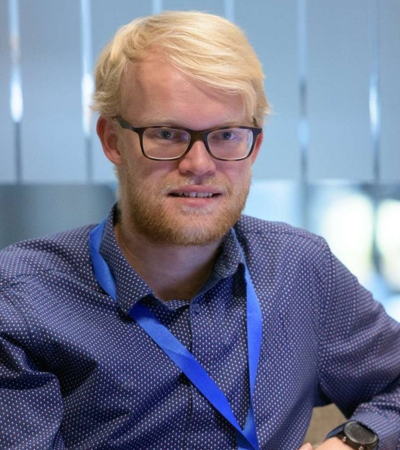Lasers and Bubbles: Thermocavitation for needle-free jet injections
Jelle Schoppink is a PhD student in the department Mesoscale Chemical Systems. Promotors are prof.dr.ir. D. Fernandez Rivas and prof.dr. J.G.E. Gardeniers from the faculty of Science & Technology.
 This thesis describes thermocavitation in microfluidic confinement, which is the generation of a vapor bubble by laser-heating of the liquid. During the growth of this bubble, it pushes the remaining liquid in the microfluidic channel out, creating a fast jet which can penetrate the skin. Therefore, this technique can be used to inject medication or other liquids, such as tattoo ink, without the use of a needle. The small size of the individual jets allows for a good control of the injected depth and volume, through the jet velocity and number of jets. Good control of the jet velocity requires understanding of the laser-liquid interaction, which is the focus of this thesis.
This thesis describes thermocavitation in microfluidic confinement, which is the generation of a vapor bubble by laser-heating of the liquid. During the growth of this bubble, it pushes the remaining liquid in the microfluidic channel out, creating a fast jet which can penetrate the skin. Therefore, this technique can be used to inject medication or other liquids, such as tattoo ink, without the use of a needle. The small size of the individual jets allows for a good control of the injected depth and volume, through the jet velocity and number of jets. Good control of the jet velocity requires understanding of the laser-liquid interaction, which is the focus of this thesis.
Two types of lasers are commonly used: pulsed and continuous-wave (CW) lasers. The pulsed laser delivers all energy in just a few nanoseconds, resulting in instantaneous bubble formation. The CW laser delivers a low and continuous amount of power, for which reason the heating is slower and the bubble only forms after a few milliseconds. Both lasers were found to generate similar bubble dynamics, but the CW laser is slightly less efficient as heat dissipation is apparent on the ms-timescale. Also, the CW-generated bubbles are slightly less reproducible due to the stochastic nature of nucleation. However, CW lasers are more affordable and smaller in size, which could increase their potential to be used in a commercial handheld device.
To further investigate thermocavitation, numerical simulations of the laser heating were compared with experimental results of the CW-generated bubbles. Increasing the laser beam size or reducing the laser power, results in delayed nucleation and faster bubble growth. This nucleation always occurred when the maximum temperature was around 237 °C. In the absence of heat dissipation, the bubble kinetic energy scales quadratically with the delivered optical energy, independent of laser beam parameters or volume of liquid. For delayed nucleation, heat dissipation cannot be neglected and the bubble kinetic energy does not scale quadratically anymore. The numerical simulations, which include this heat dissipation, indicate that the bubble kinetic energy scales with the superheated liquid volume with a power law of 4/3.
Absorption of the optical energy by a thin gold layer on the channel wall was investigated as an alternative to volumetric absorption by the liquid itself. Although this heating through the gold layer could generate bubbles and jets, they were smaller and slower compared through the direct heating of the liquid. This is explained by the different temperature profile and reduced superheated volume. Furthermore, degradation of the gold layer caused by the bubble reduces the useful operating time of the microfluidic device and reproducibility of the bubbles and jets, thus limiting the applications. Improvement through simulations and different choice of materials may overcome these problems.
Finally, surface modifications were applied to the microfluidic channel in order to improve the jet dynamics. Alternating hydrophobic and hydrophilic stripes along the jet axis enable further control over the jet formation, through two influences. Firstly, alternating wettability patterns can shape the meniscus, as the meniscus is further advanced on the hydrophilic side. Therefore, the jet has an angle towards the hydrophobic side when it is formed. Secondly, a center hydrophilic stripe bounded by two hydrophobic stripes results in a more focused jet tail. These hydrophobic stripes keep the jet tail centered, avoiding any sway.
Overall, the results in this thesis contribute to the understanding and control of laser-generated bubbles in microfluidic confinement and the resulting jet. These results are vital for further development of laser-actuated jet injection.


